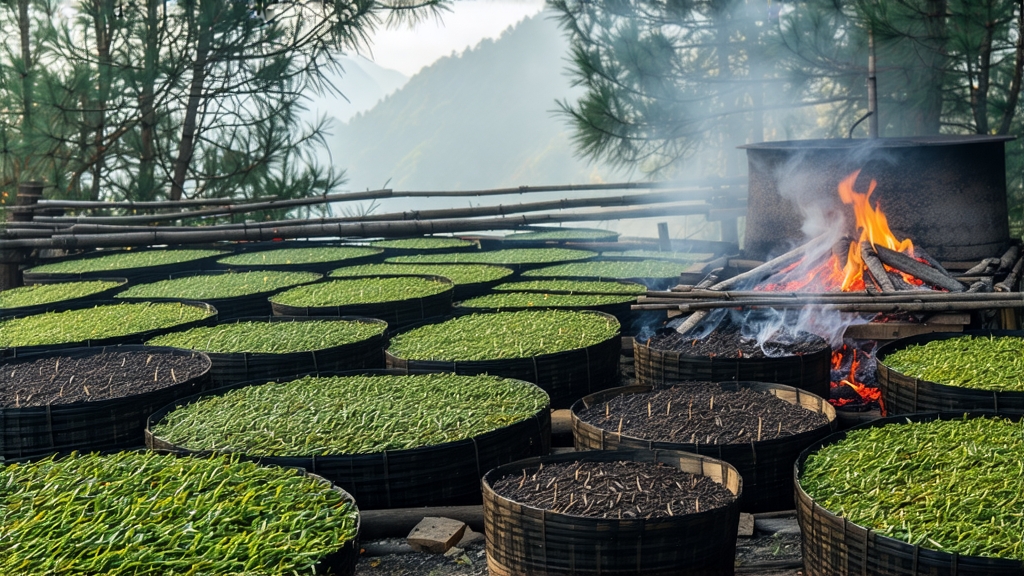
When European tea drinkers first encountered the dark, twisted leaves that produced a liquor the color of claret and a scent reminiscent of a campfire, they could not have imagined they were tasting the primordial form of all black teas. That tea, Lapsang Souchong, emerged from the granite gorges of the Wuyi Mountains in northern Fujian sometime around the mid-seventeenth century. Local legend claims it was born of urgency: Qing soldiers, so the story goes, were quartered in the village of Tongmu overnight, forcing tea farmers to speed-dry their freshly rolled leaves over fresh pine embers so they could flee before dawn. Whether apocryphal or not, the accident became a signature, and the technique—using masson pine and local cedar to smoke and dry the tea—has survived almost four centuries.
Geography is the first character in the drama. The Wuyi range is a UNESCO World Heritage labyrinth of basalt cliffs, subtropical forests, and mineral-rich streams. At 27–28° N latitude and 200–1,200 m elevation, the microclimate traps morning fog that diffuses sunlight and slows photosynthesis, concentrating amino acids and volatile aromatics in the leaves. Only cultivars that have acclimated to this thin, rocky soil—primarily small-leaf Qizhong and Wuyi Caicha—can yield the sweet, resinous base that balances smoke without turning acrid. Within Tongmu village and its six hamlets, the Chinese government has drawn a 50 km² “core origin” zone where authentic Lapsang may be produced; leaves picked outside this perimeter, even if processed identically, are legally barred from bearing the name.
Harvest follows the lunar calendar. The earliest plucks, mingqian leaves picked before Qingming (early April), are too delicate for smoking; they become unsmoked “Xiaozhong” reserved for the domestic market. The classic Lapsang Souchong is instead built from the second and third leaves on the stem—mature enough to withstand the rigors of withering, rolling, oxidation, and smoke. Pickers work between 9 a.m. and 3 p.m., when dew has evaporated yet before the afternoon heat wilts the leaf. A standard basket holds 5 kg of fresh leaf; it will shrink to 1 kg finished tea.
Withering begins the moment the leaf reaches the three-story wooden tea houses that cling to the mountainside. On the top floor, bamboo trays are stacked like drawers beneath louvered windows. Cool mountain air is funneled across the leaves for 6–8 hours, reducing moisture to 60 %. Every forty minutes a master “wei diao” (withering master) lifts a tray shoulder-high, then tilts it so the leaves cascade like green rain; the motion aerates and evenly redistributes heat. When the leaf feels leather-tough, it is rolled—first mechanically in a bamboo drum that mimics hand kneading, then by foot in the traditional manner on a rattan mat. Rolling ruptures cell walls, releasing catechins and polyphenol oxidase that will drive oxidation.
Oxidation is brief but decisive. The rolled leaf is piled in aluminum-lined wooden crates and left in a humid room kept at 24 °C and 85 % relative humidity. Forty-five minutes later the leaf edges have turned copper; the aroma shifts from grassy to apple-like. At this point most black teas would be sent to a hot-air dryer. Lapsang instead enters the smoking loft, a stone chamber whose floor is pierced with square vents. Below, pinewood and cedar are stacked into a pyramid; when the fire dies down to embers, fresh resinous sawdust is thrown on top, sending aromatic smoke upward. The tea is spread on bamboo racks 2 m above the vents; every twenty minutes the racks are slid out, the leaf tossed, and the smoke replenished. This cycle repeats for six to eight hours, until the leaf moisture falls below 5 %. The result is not a surface perfume but a deep, integrated scent: creosote, dried longan, and a hint of frankincense.
Grading follows smoke intensity. “Pinewood Lapsang” offers a gentle, almost fruity smoke and is preferred in southern Europe. “Taruk Lapsang” is smoked longer, yielding a darker leaf and a phenolic edge beloved by Russian markets. The rarest grade, “Wild Lapsang,” is picked from semi-wild bushes growing at 1,200 m, smoked only with 80